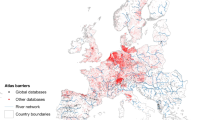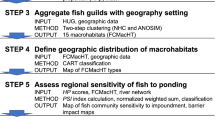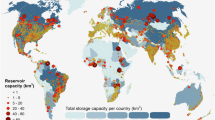Abstract
The environmental effects of large dams on river connectivity are well recognized and mapped globally. However, datasets describing the distribution and attributes of smaller barriers (such as weirs and culverts) are lacking or incomplete for many regions. This has hindered accurate impact assessments for water resource planning, biased understanding of restoration potential and limited research aiming to understand and mitigate river fragmentation effects. Developing an efficient method to accurately record river barriers, including small ones, has become a priority. We critically examine barrier mapping approaches, from field survey to automated detection, showcasing recent approaches to recording, counting and classifying river barriers. We demonstrate how incomplete barrier databases, particularly those lacking many small barriers, provide a flawed basis for water management and ecological restoration planning. We discuss the efficiency and accuracy of alternative barrier mapping approaches, highlight future priorities and emphasize harmonizing barrier assessment methods to generate reliable, freely available information for effective basin-level management.
This is a preview of subscription content, access via your institution
Access options
Subscribe to this journal
Receive 12 digital issues and online access to articles
118,99 € per year
only 9,92 € per issue
Buy this article
- Purchase on SpringerLink
- Instant access to full article PDF
Prices may be subject to local taxes which are calculated during checkout


Similar content being viewed by others
References
Reid, A. J. et al. Emerging threats and persistent conservation challenges for freshwater biodiversity. Biol. Rev. 94, 849–873 (2019).
Brauns, M. et al. A global synthesis of human impacts on the multifunctionality of streams and rivers. Glob. Change Biol. 28, 4783–4793 (2022).
Wohl, E. et al. The natural sediment regime in rivers: broadening the foundation for ecosystem management. Bioscience 65, 358–371 (2015).
Wohl, E. et al. The natural wood regime in rivers. Bioscience 69, 259–273 (2019).
Poff, N. L. et al. The natural flow regime. Bioscience 47, 769–784 (1997).
Tonkin, J. D. et al. The role of dispersal in river network metacommunities: patterns, processes, and pathways. Freshwat. Biol. 63, 141–163 (2018).
Spinti, R. A., Condon, L. E. & Zhang, J. The evolution of dam induced river fragmentation in the United States. Nat. Commun. 14, 3820 (2023).
Hughes, K. et al. The World’s Forgotten Fishes (WWF, 2021); https://wwf.panda.org/discover/our_focus/freshwater_practice/the_world_s_forgotten_fishes
He, F. et al. Hydropower impacts on riverine biodiversity. Nat. Rev. Earth Environ. https://doi.org/10.1038/s43017-024-00596-0 (2024).
Grill, G. et al. Mapping the world’s free-flowing rivers. Nature 569, 215–221 (2019).
Barbarossa, V. et al. Impacts of current and future large dams on the geographic range connectivity of freshwater fish worldwide. Proc. Natl Acad. Sci. USA 117, 3648–3655 (2020).
Caldas, B. et al. Identifying the current and future status of freshwater connectivity corridors in the Amazon Basin. Conserv. Sci. Pract. 5, e12853 (2023).
Garcia de Leaniz, C. & O’Hanley, J. R. Operational methods for prioritizing the removal of river barriers: synthesis and guidance. Sci. Total Environ. 848, 157471 (2022).
Januchowski-Hartley, S. R. et al. Restoring aquatic ecosystem connectivity requires expanding inventories of both dams and road crossings. Front. Ecol. Environ. 11, 211–217 (2013).
Couto, T. B. A. & Olden, J. D. Global proliferation of small hydropower plants – science and policy. Front. Ecol. Environ. 16, 91–100 (2018).
Belletti, B. et al. More than one million barriers fragment Europe’s rivers. Nature 588, 436–441 (2020).
Anderson, D., Moggridge, H., Warren, P. & Shucksmith, J. The impacts of ‘run-of-river’ hydropower on the physical and ecological condition of rivers. Water Environ. J. 29, 268–276 (2015).
Fantin-Cruz, I. et al. Further development of small hydropower facilities will significantly reduce sediment transport to the Pantanal wetland of Brazil. Front. Environ. Sci. 8, 577748 (2020).
Abbott, K. M., Zaidel, P. A., Roy, A. H., Houle, K. M. & Nislow, K. H. Investigating impacts of small dams and dam removal on dissolved oxygen in streams. PLoS ONE 17, e0277647 (2022).
da Cruz, R. F. et al. Water quality impacts of small hydroelectric power plants in a tributary to the Pantanal floodplain, Brazil. River Res. Appl. 37, 448–461 (2021).
Macedo, M. N. et al. Land-use-driven stream warming in southeastern Amazonia. Phil. Trans. R. Soc. B 368, 20120153 (2013).
Zaidel, P. A. et al. Impacts of small dams on stream temperature. Ecol. Indic. 120, 106878 (2021).
Arroita, M. et al. Water abstraction impacts stream ecosystem functioning via wetted‐channel contraction. Freshwat. Biol. 62, 243–257 (2017).
Couto, T. B. A. et al. Effects of small hydropower dams on macroinvertebrate and fish assemblages in southern Brazil. Freshwat. Biol. 68, 956–971 (2023).
Lessard, J. L. & Hayes, D. B. Effects of elevated water temperature on fish and macroinvertebrate communities below small dams. River Res. Appl. 19, 721–732 (2003).
Sun, J., Galib, S. M. & Lucas, M. C. Are national barrier inventories fit for stream connectivity restoration needs? A test of two catchments. Water Environ. J. 34, 791–803 (2020).
Sun, J. et al. Convolutional neural networks facilitate river barrier detection and evidence severe habitat fragmentation in the Mekong River biodiversity hotspot. Water Resour. Res. 60, e2022WR034375 (2024).
Couto, T. B. A., Messager, M. L. & Olden, J. D. Safeguarding migratory fish via strategic planning of future small hydropower in Brazil. Nat. Sustain. 4, 409–416 (2021).
Engel, F. et al. Phytoplankton gross primary production increases along cascading impoundments in a temperate, low-discharge river: insights from high frequency water quality monitoring. Sci. Rep. 9, 6701 (2019).
Jones, P. E. et al. Selective effects of small barriers on river‐resident fish. J. Appl. Ecol. 58, 1487–1498 (2021).
Morden, R., Horne, A., Bond, N. R., Nathan, R. & Olden, J. D. Small artificial impoundments have big implications for hydrology and freshwater biodiversity. Front. Ecol. Environ. 20, 141–146 (2022).
Sun, J. et al. River fragmentation and barrier impacts on fishes have been greatly underestimated in the upper Mekong River. J. Environ. Manage. 327, 116817 (2023).
Zarfl, C., Lumsdon, A. E., Berlekamp, J., Tydecks, L. & Tockner, K. A global boom in hydropower dam construction. Aquat. Sci. 77, 161–170 (2015).
Yu, Y. et al. Transboundary cooperation in infrastructure operation generates economic and environmental co-benefits in the Lancang-Mekong River Basin. Nat. Water 2, 589–601 (2024).
Lehner, B. et al. High‐resolution mapping of the world’s reservoirs and dams for sustainable river‐flow management. Front. Ecol. Environ. 9, 494–502 (2011).
Birnie-Gauvin, K., Tummers, J. S., Lucas, M. C. & Aarestrup, K. Adaptive management in the context of barriers in European freshwater ecosystems. J. Environ. Manage. 204, 436–441 (2017).
Mulligan, M. et al. Global Dam Watch: curated data and tools for management and decision making. Environ. Res. Infrastruct. Sustain. 1, 033003 (2021).
Flecker, A. S. et al. Reducing adverse impacts of Amazon hydropower expansion. Science 375, 753–760 (2022).
King, S., O’Hanley, J. R., Newbold, L. R., Kemp, P. S. & Diebel, M. W. A toolkit for optimizing fish passage barrier mitigation actions. J. Appl. Ecol. 54, 599–611 (2017).
Silva, A. T. et al. The future of fish passage science, engineering, and practice. Fish Fisher. 19, 340–362 (2018).
Sun, J., Tummers, J. S., Galib, S. M. & Lucas, M. C. Fish community and abundance response to improved connectivity and more natural hydromorphology in a post-industrial subcatchment. Sci. Total Environ. 802, 149720 (2022).
Jumani, S. et al. A decision‐support framework for dam removal planning and its application in northern California. Environ. Chall. 12, 100731 (2023).
Winemiller, K. O. et al. Balancing hydropower and biodiversity in the Amazon, Congo, and Mekong. Science 351, 128–129 (2016).
Thieme, M. et al. Measures to safeguard and restore river connectivity. Environ. Rev. 32, 366–386 (2023).
Ziv, G., Baran, E., Nam, S., Rodriguez-Iturbe, I. & Levin, S. A. Trading-off fish biodiversity, food security, and hydropower in the Mekong River Basin. Proc. Natl Acad. Sci. USA 109, 5609–5614 (2012).
Almeida, R. M. et al. Strategic planning of hydropower development: balancing benefits and socioenvironmental costs. Curr. Opin. Environ. Sustain. 56, 101175 (2022).
Opperman, J. J. et al. Balancing renewable energy and river resources by moving from individual assessments of hydropower projects to energy system planning. Front. Environ. Sci. 10, 1036653 (2023).
Yang, X. et al. Mapping flow‐obstructing structures on global rivers. Water Resour. Res. 58, e2021WR030386 (2022).
Zhang, A. T. & Gu, V. X. Global Dam Tracker: a database of more than 35,000 dams with ___location, catchment, and attribute information. Sci. Data 10, 111 (2023).
Lehner, B. et al. The Global Dam Watch database of river barrier and reservoir information for large-scale applications. Sci. Data 11, 1069 (2024).
Donchyts, G. et al. High-resolution surface water dynamics in Earth’s small and medium-sized reservoirs. Sci. Rep. 12, 13776 (2022).
World Register of Dams (International Commission on Large Dams, 2022); https://www.icold-cigb.org/GB/world_register/world_register_of_dams.asp
Les Obstacles à l’Écoulement des Eaux de Surface – Continuité Écologique (Onema, 2022); https://www.eaufrance.fr/les-obstacles-lecoulement-des-eaux-de-surface
Mulligan, M., van Soesbergen, A. & Sáenz, L. GOODD, a global dataset of more than 38,000 georeferenced dams. Sci. Data 7, 31 (2020).
Gao, J., Castelletti, A., Burlado, P., Wang, H. & Zhao, J. Soft-cooperation via data sharing eases transboundary conflicts in the Lancang-Mekong River Basin. J. Hydrol. 606, 127464 (2022).
Lin, J. et al. Making China’s water data accessible, usable and shareable. Nat. Water 1, 328–335 (2023).
Sheer, M. B. & Steel, E. A. Lost watersheds: barriers, aquatic habitat connectivity, and salmon persistence in the Willamette and Lower Columbia river basins. Trans. Am. Fish. Soc. 135, 1654–1669 (2006).
Jones, J. et al. A comprehensive assessment of stream fragmentation in Great Britain. Sci. Total Environ. 673, 756–762 (2019).
Mapping Hydropower Opportunities and Sensitivities in England and Wales (Entec, 2010).
Baumgartner, L. J., Marsden, T., Duffy, D., Horta, A. & Ning, N. Optimizing efforts to restore aquatic ecosystem connectivity requires thinking beyond large dams. Environ. Res. Lett. 17, 014008 (2022).
Marsden, T., Baumgartner, L. J., Duffy, D., Horta, A. & Ning, N. Evaluation of a new practical low-cost method for prioritising the remediation of fish passage barriers in resource-deficient settings. Ecol. Eng. 194, 107024 (2023).
Mouchlianitis, F. A. AMBER Barrier Tracker: Using Citizen Science to Track Barriers in Europe (World Fish Migration Foundation, 2022); https://damremoval.eu/wp-content/uploads/2023/01/BarrierTracker_report2022finale.pdf
Atkinson, S. et al. The value of a desk study for building a national river obstacle inventory. River Res. Appl. 34, 1085–1094 (2018).
Whittemore, A. et al. A participatory science approach to expanding instream infrastructure inventories. Earth Future 8, e2020EF001558 (2020).
Buchanan, B. P. et al. A machine learning approach to identify barriers in stream networks demonstrates high prevalence of unmapped riverine dams. J. Environ. Manage. 302, 113952 (2022).
Parks, M. V., Garcia de Leaniz, C., Jones, P. E. & Jones, J. Modelling remote barrier detection to achieve free-flowing river targets. Environ. Res. Lett. 19, 084055 (2024).
Arsenault, M. et al. Remote sensing framework details riverscape connectivity fragmentation and fish passability in a forested landscape. J. Ecohydraul. 8, 121–132 (2023).
Kroon, F. J. & Phillips, S. Identification of human-made physical barriers to fish passage in the Wet Tropics region, Australia. Mar. Freshwat. Res. 67, 677–681 (2016).
Lehner, B., Verdin, K. & Jarvis, A. New global hydrography derived from spaceborne elevation data. Eos 89, 93–94 (2008).
Januchowski-Hartley, S. R., Jézéquel, C. & Tedesco, P. A. Modelling built infrastructure heights to evaluate common assumptions in aquatic conservation. J. Environ. Manage. 232, 131–137 (2019).
Jing, M. et al. Detecting unknown dams from high-resolution remote sensing images: a deep learning and spatial analysis approach. Int. J. Appl. Earth Obs. Geoinf. 104, 102576 (2021).
Hübinger, C., Fluet-Chouinard, E., Hugelius, G., Peña, F. J. & Jaramillo, F. Automating the detection of hydrological barriers and fragmentation in wetlands using deep learning and InSAR. Remote Sens. Environ. 311, 114314 (2024).
Sharma, K. High performance GPU based optimized feature matching for computer vision applications. Optik 127, 1153–1159 (2016).
Ioannidou, C. T., Neeson, T. M. & O’Hanley, J. R. Boosting large‐scale river connectivity restoration by planning for the presence of unrecorded barriers. Conserv. Biol. 37, e14093 (2023).
Garcia de Leaniz, C. et al. in From Sea to Source 2.0: Protection and Restoration of Fish Migration in Rivers Worldwide (eds Brink, K. et al.) 142–145 (World Fish Migration Foundation, 2018).
Cowx, I. G. et al. Understanding the threats to fish migration: applying the global swimways concept to the Lower Mekong. Rev. Fisher. Sci. Aquacult. https://doi.org/10.1080/23308249.2024.2401018 (2024).
Perkin, J. S. & Gido, K. B. Fragmentation alters stream fish community structure in dendritic ecological networks. Ecol. Appl. 22, 2176–2187 (2012).
Branco, P., Amaral, S. D., Ferreira, M. T. & Santos, J. M. Do small barriers affect the movement of freshwater fish by increasing residency? Sci. Total Environ. 581–582, 486–494 (2017).
Marsden, T., Peterken, C., Baumgartner, L. & Thorncraft, G. Guideline to Prioritising Fish Passage Barriers and Creating Fish Friendly Irrigation Structures (Mekong River Commission, 2014); https://researchoutput.csu.edu.au/files/19101127/2014_Holistic_Approach_to_Fish_Passage_Remediation_Mekong.pdf
Rosa, C. et al. Burying water and biodiversity through road constructions in Brazil. Aquat. Conserv. 31, 1548–1550 (2021).
Azevedo-Santos, V. M. et al. Irrigation dams threaten Brazilian biodiversity. Environ. Manage. 73, 913–919 (2024).
Cote, D., Kehler, D. G., Bourne, C. & Wiersma, Y. F. A new measure of longitudinal connectivity for stream networks. Landsc. Ecol. 24, 101–113 (2009).
Jumani, S. et al. River fragmentation and flow alteration metrics: a review of methods and directions for future research. Environ. Res. Lett. 15, 123009 (2020).
Li, M. et al. Human barriers fragment three-quarters of all rivers in the Mekong basin. Renew. Sustain. Energy Rev. 210, 115158 (2025).
O’Hanley, J. R., Wright, J., Diebel, M., Fedora, M. A. & Soucy, C. L. Restoring stream habitat connectivity: a proposed method for prioritizing the removal of resident fish passage barriers. J. Environ. Manage. 125, 19–27 (2013).
Branco, P., Segurado, P., Santos, J. M. & Ferreira, M. T. Prioritizing barrier removal to improve functional connectivity of rivers. J. Appl. Ecol. 51, 1197–1206 (2014).
King, M., van Zyll de Jong, M. & Cowx, I. G. A dynamic dendritic connectivity assessment tool for the planning and design of barrier mitigation strategies in river networks. Landsc. Ecol. 38, 1431–1446 (2023).
Slagter, B. et al. Monitoring road development in Congo Basin forests with multi-sensor satellite imagery and deep learning. Remote Sens. Environ. 315, 114380 (2024).
Tang, Q. et al. Automatic extraction of glacial lakes from Landsat imagery using deep learning across the Third Pole region. Remote Sens. Environ. 315, 114413 (2024).
Fish-friendly Irrigation: Guidelines to Prioritising Fish Passage Barriers in the Lower Mekong River Basin (Mekong River Commission, 2023); https://www.mrcmekong.org/wp-content/uploads/2024/08/Fish-Friendly-Irrigation-Guidelines-to-Prioritize-Fish-Passage-Barriers-in-the-Lower-Mekong-River-Basin.pdf
Acknowledgements
J.S. was funded by the National Natural Science Foundation of China (grant no. 42301064). J.D.O. was supported by the Richard C. and Lois M. Worthington Endowed Professor in Fisheries Management from the School of Aquatic and Fishery Sciences, University of Washington. T.B.A.C. is funded by the United Kingdom Research and Innovation (UKRI) Future Leaders Fellowship (grant no. MR/W011085/1). We thank M. Thieme and B. Lehner for valuable discussions and comments on the topic.
Author information
Authors and Affiliations
Contributions
All authors contributed to the conceptualization of the Review and discussions of the content. J.S. led the writing and all authors contributed substantially to the drafts of the manuscript. All authors reviewed and edited the manuscript before submission.
Corresponding author
Ethics declarations
Competing interests
The authors declare no competing interests.
Peer review
Peer review information
Nature Water thanks Luca De Felice, Xiao Yang and the other, anonymous, reviewer(s) for their contribution to the peer review of this work.
Additional information
Publisher’s note Springer Nature remains neutral with regard to jurisdictional claims in published maps and institutional affiliations.
Rights and permissions
Springer Nature or its licensor (e.g. a society or other partner) holds exclusive rights to this article under a publishing agreement with the author(s) or other rightsholder(s); author self-archiving of the accepted manuscript version of this article is solely governed by the terms of such publishing agreement and applicable law.
About this article
Cite this article
Sun, J., Lucas, M.C., Olden, J.D. et al. Towards a comprehensive river barrier mapping solution to support environmental management. Nat Water 3, 38–48 (2025). https://doi.org/10.1038/s44221-024-00364-w
Received:
Accepted:
Published:
Issue Date:
DOI: https://doi.org/10.1038/s44221-024-00364-w



